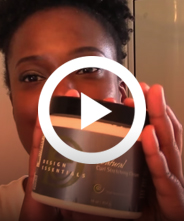Winter is officially here… so you know what that means…it’s protective hairstyling season. For those unaware, protective styling is manipulating your hair in a way, so that your ends are tucked away to protect your strands from the harsh elements of cold weather. Without question, many of us know this hair regimen in the form of braids!
Braids underneath our weaves and wigs, box braids, Senegalese twists, Marley braids, or just traditional corn rows, you name it, and we will braid our hair up by any means necessary to give it a well-deserved break.
When maintained correctly, braids are a very low maintenance, yet stylish solution to promoting healthy hair growth IF you pay close attention to the health of your hair and scalp. All too often, we believe braids are the magic trick to automatically achieving longer hair lengths since our hair isn’t being manipulated as much as it would be on a daily basis.
However when adorning braids of any kind, it’s very important to follow frequent braid and scalp therapy regimens in order to avoid common hair and scalp conditions such as dry, itchy scalp and disorders such as dandruff and excema. Not to mention, other downfalls associated with braided styles like tangling, shedding, and excessive hair breakage.
So to help you achieve and retain beautifully healthy hair while wearing your favorite protective styles this season, we’ve gathered a list of do’s, don’ts, and product must haves for what we’d like to call Braid & Scalp Therapy 101:
Tip 1: Before braiding your hair, do properly cleanse your hair and scalp with a moisturizing sulfate-free shampoo to remove oil, dirt, and product build-up. We recommend Design Essential’s Strengthening Therapy Cleansing-Sulfate Free Shampoo. This will help cleanse both your hair and scalp without stripping it of essential oils and nutrients. Follow-up with our Express Instant Moisturizing Conditioner to seal your cuticle and lock in added moisture.
Tip 2: Don’t believe the hype “If it’s not tight, it’s not right”….that’s just foolishness! When done correctly, braids shouldn’t cause any tension on your scalp. In fact, too much tension can result in Traction alopecia, the gradual loss of hair caused primarily by a pulling force being applied to the hair and scalp. This is commonly seen more often in African American women with certain braiding patterns that pull the hairline forcefully, which can cause balding and scarring.
Tip 3: Do frequently oil your scalp, hair, and braids as needed with lightweight natural oil. Try Design Essential’s Botanical Oils, perfect for conditioning and revitalizing dry, dull looking hair, while adding a natural shine!
Tip 4: To prevent hair breakage, don’t wear braids longer than 8-12 weeks. By this point you’ve probably seen a considerable amount of new-growth, and the last thing you want to happen is for you hair to break or snap at the line of demarcation (in this case, the point where your new-growth meets your natural hair) due to excessive stress at this point.
Tip 5: Do regularly cleanse your braids as you would your natural hair. For example, still shampoo every 7-10 days to rid hair and scalp of dirt and build-up, and if possible deep condition once a week to help reduce hair breakage and shedding. We suggest Design Essential’s Deep Fortifying Hair Treatment to do the trick!
Tip 6: Last, but not least, after taking down your braids, DO NOT, we repeat DO NOT completely wet, shampoo, or condition your hair before detangling with a wide tooth comb first (some may disagree based on hair type). But for majority of us, not combing out the kinks, knots, product residue, and/or whatever else has been hiding in your braids for the past 3 months can cause serious tangling and hair breakage once completely wet.
Therefore we recommend patiently detangling your hair while it’s still dry, starting at the ends and working your way up to the roots. If needed, use a spray bottle with water and conditioner to make the process a bit easier. But remember patience is key; you don’t want to lose all that healthy hair growth you worked so hard to retain and protect this season!
http://blog.designessentials.com/articles/braid-scalp-therapy-101/





